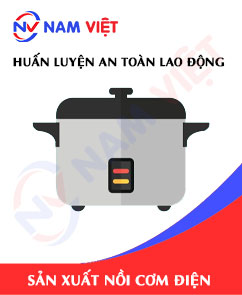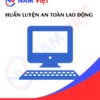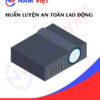Occupational Safety Training in Rice Cooker Manufacturing
99,000 ₫
Note: The above price is calculated per person, and the price may fluctuate depending on the number of trainees participating in the course and the market movements. For more accurate price support, please refer to the price list or contact our consulting staff directly.
Occupational safety is an important issue in factories manufacturing rice cookers and needs to be addressed promptly to ensure the health and safety of workers and enhance the reputation of businesses. The Occupational Safety Training course is one of the effective solutions to raise awareness about preventing workplace accidents for workers participating in rice cooker manufacturing.
Table of Contents
Toggle1. Overview of Rice Cookers
a. What is a rice cooker?
A rice cooker is a common household appliance used to cook rice by using electric heat or a temperature sensor to automatically adjust the cooking temperature and time.
There are many types of rice cookers on the market, ranging from simple models with basic functions such as cooking white rice, to more advanced models with multiple functions such as cooking brown rice, large grain rice, porridge, soups, stews, steaming, stir-frying, frying, baking, dessert cooking, and nut milk preparation.

b. Machinery used in rice cooker production
The machinery and equipment used in rice cooker manufacturing include:
- Stamping machines: used to cut and punch metal parts.
- Laser cutting machines: used to cut parts with laser beams.
- Bending machines: used to bend metal parts into required shapes.
- Welding machines: used to weld metal components together.
- Heating machines: used to preheat metal parts before processing.
- Milling machines: used to cut and create slots in metal parts.
- Grinding machines: used to polish and shape metal parts.
- Plastic injection machines: used to mold plastic components.
- Plastic cutting machines: used to cut plastic parts.
- Printing machines: used to print images, logos, and information on plastic parts.
- Packaging machines: used to package rice cookers after production is complete.

c. Rice cooker manufacturers in Vietnam
In Vietnam, there are many companies producing and selling rice cooker products, including:
- Kangaroo Group: Kangaroo is a well-known and long-established brand in Vietnam with many household appliances, including rice cookers.
- Sunhouse: Sunhouse specializes in household appliances, including rice cookers, and is a well-known brand both in Vietnam and internationally.
- Electrolux: Electrolux is a globally recognized brand in household appliances, including rice cookers.
- Toshiba: Toshiba is a major brand in electronics and household appliances, including rice cookers.
- Philips: Philips is a globally recognized brand for electronics and household appliances, including rice cookers.
- Panasonic: Panasonic is a well-known brand in electronics and household appliances worldwide, including rice cookers.

d. Specific jobs in a rice cooker manufacturing factory
Group 1
- CEO, deputy CEO, and department heads in the rice cooker manufacturing factory.
Group 2
- Safety officers: manage safety in the factory, design safety procedures, monitor and ensure employees follow safe working procedures.
Group 3
- Component production: Components of rice cookers, such as lids, pots, ovens, control panels, etc., are manufactured according to specific dimensions and shapes.
- Assembly: After producing components, employees assemble them into complete products.
- Product inspection: After assembly, rice cookers are thoroughly inspected to ensure product quality.
- Product packaging: After inspection, products are packed in boxes for delivery.
- Product transportation: Rice cookers are transported from the factory to distributors, supermarkets, or other retail stores nationwide.
Group 4
- Office, service, sales, and marketing jobs.
- Production management, quality management, human resource management, material management, finance and accounting management.
- Research and development of new products, product packaging design.

2. Overview of occupational safety training for rice cooker production
In this article, we focus on issues related to Group 3, because Group 3 directly participates in production and faces the highest occupational safety risks. For more information about other groups, see here.
a. What is Group 3 occupational safety training?
- Group 3 occupational safety training consists of classes that provide workers with awareness of accident prevention methods.
- The safety training course helps workers identify and avoid hazards, reducing the risk of occupational accidents while working.
REGISTER FOR OCCUPATIONAL SAFETY TRAINING SERVICE
b. Training duration
Initial safety training
- Total training duration is at least 24 hours, including examination time.
- 8 hours of theory on occupational safety and hygiene policies and laws.
- 8 hours of theory on basic knowledge of occupational safety and hygiene.
- 4 hours of theory on specialized training content.
- 2 hours of practice on specialized training content.
- 2 hours of theoretical examination at the end of the course.
The training center will schedule sessions depending on the availability of workers. Typically, there are 6 training sessions over 3 days, provided the company can allocate continuous training time.
Periodic safety training
- Before the occupational safety card expires, workers must undergo periodic occupational safety training for at least 50% of the initial training duration if they wish to renew their card.
Explanation: total periodic occupational safety training duration is at least 12 hours, including examination time. After completing the periodic training and passing the test, workers will have their occupational safety cards renewed.
c. Training content
| No. | TRAINING CONTENT | TRAINING DURATION (HOURS) | |||
| Total | Including | ||||
| Theory | Practice | Examination | |||
| I | Occupational safety and hygiene policies and laws | 8 | 8 | 0 | 0 |
| 1 | Overview of occupational safety and hygiene legal documents. | 6 | 6 | ||
| 2 | Standards and technical regulations for occupational safety and hygiene. | 1 | 1 | ||
| 3 | Specific regulations from government agencies on occupational safety and hygiene for construction, expansion, or renovation of facilities, and the use, storage, and inspection of machinery, equipment, materials, and substances with strict safety requirements. | 1 | 1 | ||
| II | Basic knowledge of occupational safety and hygiene | 8 | 8 | 0 | 0 |
| 1 | Basic knowledge of workplace hazards and harmful factors. | 4 | 4 | ||
| 2 | Methods to improve working conditions. | 1 | 1 | ||
| 3 | Safety culture in production and business. | 1 | 1 | ||
| 4 | Rights and obligations of employers and employees; occupational safety and hygiene policies and benefits; functions and duties of safety networks. | 1 | 1 | ||
| 5 | Occupational safety rules, signs, instructions, use of safety equipment and personal protective equipment; first aid and occupational disease prevention skills. | 1 | 1 | ||
| III | Specialized training content | 6 | 4 | 2 | 0 |
| Comprehensive knowledge of machinery, equipment, substances generating hazards; risk analysis, evaluation, and management for occupational safety and hygiene; safe working procedures for machinery, equipment, and substances with strict safety requirements. | 6 | 4 | 2 | ||
| IV | Final safety training examination | 2 | 2 | 0 | 0 |
| Total | 24 | 22 | 2 | ||
See more training content of 6 groups
d. Occupational safety card
After completing the occupational safety training and passing the examination, workers will be issued an occupational safety card (commonly called Group 3 occupational safety certificate).
The Group 3 safety card shows personal information such as full name, date of birth, job, and work environment, along with training duration, red stamp, and signature confirming course completion.
According to Clause 2 of Article 24 of Decree 44/2016/ND-CP, there are two cases:
- If the employer and employee have a labor contract, the employer must sign, stamp, and validate the safety card for Group 3 trainees after they complete the training course and pass the test.
- If the worker is freelance or seasonal and does not have a labor contract, the training unit must sign, stamp, and validate the safety card after the worker completes the training course and passes the test.

3. Identifying hazards affecting workers when manufacturing rice cookers
Some hazards that may affect workers during rice cooker production include:
- Risk of electric shock: Employees frequently come into contact with electricity and electronic components when assembling and testing rice cookers. If components are faulty or improperly installed, it may result in electric shock hazards.
- Risk of fire and explosion: The use of flammable materials during rice cooker production can lead to fire and explosion risks. To minimize this risk, employees must follow safety procedures and ensure materials meet quality and safety standards.
- Risk of injury: Employees often have to transport and lift heavy rice cooker parts during production. If proper lifting techniques or supporting equipment are not used, this may lead to injury risks.
- Risk of chemical exposure: The rice cooker production process may involve chemicals such as solvents, adhesives, coatings, and other hazardous compounds. Without proper protective equipment and safety procedures, employees may be exposed to these harmful substances.
- Risk of machinery accidents: Machines used in rice cooker production can pose accident risks if employees do not follow safety procedures when operating machinery.

4. Common occupational accidents for workers during rice cooker production
Common occupational accidents for workers during rice cooker production include:
- Fire and explosion accidents: The production process involves devices and materials that are flammable and explosive, not to mention chemical usage. Failure to comply with safety regulations may cause fire or explosion hazards and endanger workers.
- Cutting and piercing accidents: During processing, the use of cutting, drilling, and grinding equipment may lead to cutting accidents if workers do not wear proper protective equipment or use devices incorrectly.
- Falls and collisions: These accidents usually occur when workers move or transport components and equipment during production. Non-compliance with safety rules can result in hazards.
- Electrical accidents: Rice cooker production involves using electrical power and devices, which may cause electric shock if used improperly.
- Chemical accidents: Workers may need to use chemicals for processing, cleaning, or maintenance. Improper usage can endanger their health.

5. Safety measures when participating in rice cooker production
Some safety measures when participating in rice cooker production include:
- Ensuring operator safety: Employees must be trained in techniques and occupational safety. They should be provided with full protective equipment such as helmets, safety glasses, masks, gloves, safety shoes, and protective clothing. Employees must ensure hands and other body parts are not trapped in machines during operation.
- Ensuring electrical safety: Since rice cookers are electrical devices, ensuring electrical safety is critical. Motors, compressors, pumps, and other electrical equipment must be inspected regularly to ensure proper functioning and prevent fire or explosion hazards.
- Using protective devices: The rice cooker factory should implement protective devices such as safety locks, optical sensors, collision sensors, automatic power shut-offs, overload protection systems, and other protective equipment to ensure employee and equipment safety.
- Controlling fire and explosion risks: The factory must manage fire and explosion hazards by using fire-resistant materials and fire-protection devices.
- Regular maintenance: Rice cooker production equipment must be maintained regularly to ensure safe operation and prevent hazards to workers.
- Ensuring food safety hygiene: As rice cookers are used for cooking, production processes and equipment must comply with food safety hygiene standards to protect consumer health.
- Occupational safety training: Operators of rice cooker production machinery must be trained to identify and prevent hazards.
- Periodically conduct workplace environmental monitoring in factories, collecting and analyzing harmful factors to reduce risk levels and prevent occupational diseases for workers.
6. Benefits of occupational safety training in rice cooker production
An Toan Nam Viet provides your business with the following benefits after completing occupational safety training courses as stipulated in Decree 44/2016/NĐ – CP on Occupational Safety and Health for companies, factories, and enterprises.
- Workers can identify potential occupational hazards and take preventive measures to avoid accidents.
- Your enterprise can establish risk prevention measures in production, operation, and maintenance processes.
- Minimizes costs associated with workplace safety risks.
- Uninterrupted production helps increase labor productivity and product quality.
- Complying with labor safety laws reduces legal risks.
- Enhances credibility and professionalism, thereby elevating your enterprise’s brand.
Nam Viet’s training courses are a solution to prevent and mitigate external factors impacting individuals, helping them avoid hazards that could lead to injuries or, in severe cases, death.
REGISTER FOR OCCUPATIONAL SAFETY TRAINING SERVICES
7. Customer feedback after completing occupational safety training for rice cooker production
An Toan Nam Viet has years of experience accompanying many enterprises in Vietnam in general and in the southern provinces in particular. This responsibility is extremely valuable to Nam Viet, which is why its Occupational Safety Training programs are increasingly professional. The motivation for Nam Viet’s growth comes from both positive feedback and suggestions from enterprises. Below are feedbacks from partners we have served.
Hoa Dat Construction & Trading Joint Stock Company
“Nam Viet’s service has greatly helped us simplify occupational safety and complete safety documentation for work processes. The consulting team is enthusiastic and timely in answering our queries. 5 stars for Nam Viet.”
See more customer interviews after using services of An Toan Nam Viet
8. Occupational Safety Training Capacity of An Toan Nam Viet
An Toan Nam Viet is a reputable and high-quality occupational safety training center in Vietnam. Training sessions are continuously conducted at production workshops, factories, or construction sites across all 63 provinces in Vietnam.
REGISTER FOR OCCUPATIONAL SAFETY TRAINING SERVICES
Occupational Safety Training License
- An Toan Nam Viet has been inspected and certified by the Department of Occupational Safety under the Ministry of Labor – Invalids and Social Affairs and issued a certificate confirming eligibility to conduct occupational safety and hygiene training. This further strengthens our occupational safety training capabilities.

Documents and lectures
- Before being used in Occupational Safety Training Courses, training materials are reviewed to ensure content accuracy and effectiveness.
- Instructors’ teaching methods follow An Toan Nam Viet standards, developed by experts in occupational safety and hygiene training to maximize knowledge retention for trainees.
Facilities
- Controlling classroom factors affecting training improves teaching efficiency and knowledge absorption.
- Our training facilities provide spacious classrooms meeting standards for area, lighting, and training equipment.
9. Nationwide reputable occupational safety training center
At An Toan Nam Viet, we prioritize professional dedication to occupational safety training. Teaching workers to protect themselves equips them with safety skills for their livelihoods and contributes to national development.
To ensure training effectiveness, we meticulously prepare all aspects, including tools, teaching equipment, curriculum, materials, sound, and lighting.
Our occupational safety instructors are experts with years of experience and research on hazard identification across industries and prevention methods.
Lectures are practical, engaging, and easy for workers to understand. Training content strictly follows Decree 44/2016/NĐ-CP.
Trainees learn hazard prevention measures and how to protect themselves, applying them effectively in their work.
Our training center proudly provides reputable, professional occupational safety training with the following advantages:
- Competitive training costs with guaranteed quality.
- Flexible training schedule according to company production.
- Quick certification procedures in compliance with legal regulations.
- Experienced instructors with years of expertise.
- Classrooms with controlled factors to enhance teaching efficiency and knowledge retention.
- Customized lectures suitable for occupational safety in enterprises.
- Dedicated, professional service for accurate and fast client support.

10. Additional reference materials for occupational safety training in rice cooker production
- Occupational Safety Training Materials Set
- Rice Cooker Production Safety Materials
- Occupational Safety Training Exam Set
- Occupational Safety Training Curriculum for Rice Cooker Production
- Rice Cooker Production Safety Multiple-Choice Test
1 review for Occupational Safety Training in Rice Cooker Manufacturing
No comments yet















namchinh.haiphong341
Dịch vụ ở đây tốt nhé!